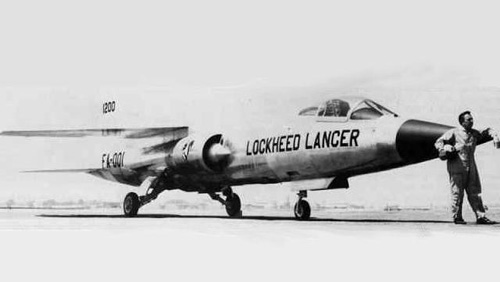X-27 Lancer

Specifications Company-
Lockheed-California
Type-
CL-1200 Lancer.
Goals- Advanced,
lightweight fighter.
Primary Testing Facility
Research- None
Dimensions- Span- 28 ft,
7 in; Length- 53 ft, 2 in; Height: 16 ft, 2 in
Max Speed-
1,450 MPH
Range- 2,100 miles
Max Altitude-
60,000 ft
Power Plant- One Pratt &
Whitney TF30-PW-100
Thrust- Without
Afterburner: 15,000 lbf; Afterburner: 25,000 lbf
Weights-
Empty: 17,250 lbs; Fully Loaded: 32,500 lbs
Payload- N/A
Flights-
None
Number of Prototypes Built- None
Project Tenure-
None
Project Status- Cancelled Information
The CL-1200 retained the basic F-104 fuselage but
was fitted with a shoulder-mounted wing of larger area which was moved
further aft. The new wing had a span of 29 feet and still featured
leading- and trailing-edge flops plus inner strakes. The tailplane was
moved from the tip of the vertical fin to the base of the rear fuselage.
in order to avoid the downwash effects from the high set wings at high
angles of attack and to eliminate the Starfighter's inherent pitch-up
problems.
The first version was to be the CL-1200-1, still
with the now well- proven J79-GE-19 engine. The more advanced CL-1200-2
was to have had a redesigned rear fuselage that could accommodate a
modern turbofan engine rather than the J79 turbojet. This turbofan
engine was to be either the Pratt & Whitney TF30-P-100 or the
F100-P-100. These engines offered an increase of 60 percent in thrust at
maximum power. The air intakes were located in the same place that they
were on the F-104, but they incorporated translating shock cones with
four-inch movement in place of the F-104's fixed cones.
The Lancer retained the 20-mm General Electric
M-61A1 cannon as its primary built-in armament, although a 30-mm DEFA
gun could be fitted as an alternative if the customer so desired. Nine
weapons stations were provided, one under the fuselage, three under each
wing, and one at each wingtip. Up to 12,000 pounds of ordinance could be
carried.
The estimated gross weight was 35,000 pounds and a
top speed of 1700 mph at 35,000 feet was envisaged. The takeoff run was
1450 feet in the intercept configuration, only 52 percent of that
required for the F-104G. Kelly Johnson projected that the CL-1200-2
would be superior in air-to-air combat to any known fighter.
The CL-1200 was entered in the International
Fighter Aircraft competition to find a replacement for the Northrop F-5
Freedom Fighter in the international market. It was projected that
CL-1200 deliveries could begin in 1974. However, in November 1970 the
Northrop F-5-21 was named the winner of the competition, and the primary
market for the Lancer was lost. The project was then terminated.
Another stillborn Starfighter derivative was the
CL-704 VTOL strike and reconnaissance aircraft originally proposed in
1962. For VTOL operations, it was to have had seven vertically-mounted
Rolls Royce RB.181s in each of the enlarged wingtip pods. The main
forward propulsion was to have been provided by a fuselage-mounted Rolls
Royce RB.168.
A larger-winged F-104 derivative was proposed as an
alternative to the MRCA (Multi-Role Combat Aircraft) then being designed
as a multi-national European project. Nothing ever emerged, and the MRCA
eventually emerged as the Panavia Tornado.
At one time, the USAF had considered acquiring one
or more examples of the Lancer. The USAF planned to buy at least one
experimental Lancer under the experimental designation X-27 for Mach 2.6
testing. The X-27 was to be similar in overall configuration to the
Lancer but was to feature modified engine air intakes having a
rectangular shape. However, the X-27 program received almost no U.S.
congressional or Air Force support. Due to the lack of monetary support,
no flight capable aircraft were constructed. One full-scale mockup was
built by Lockheed, although up to 3 fuselages had been converted prior
to the shutdown of the project. ** Information provided by
Wikipedia ** |